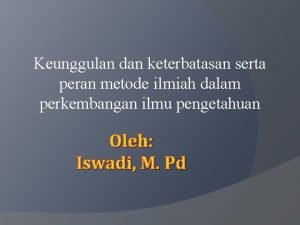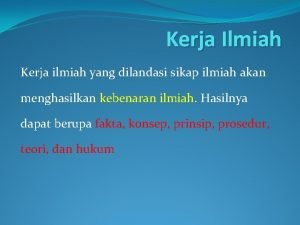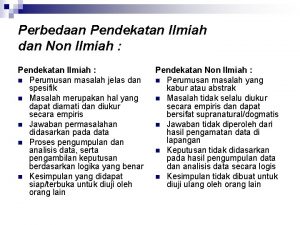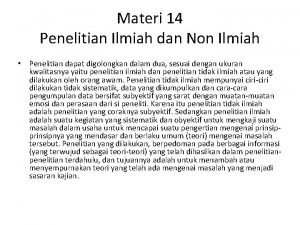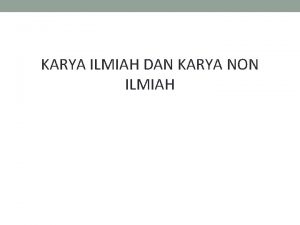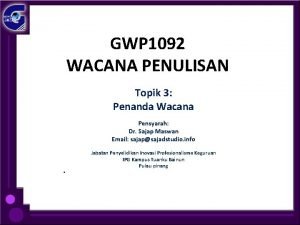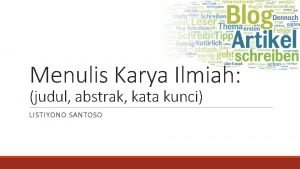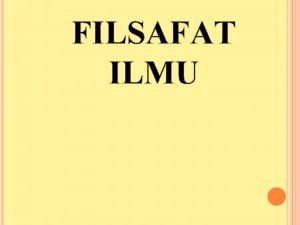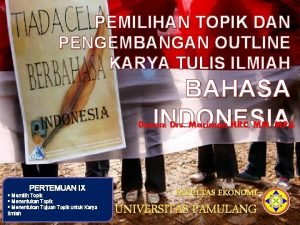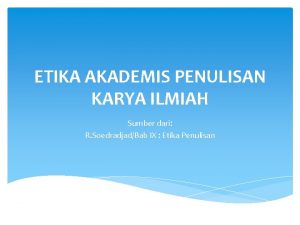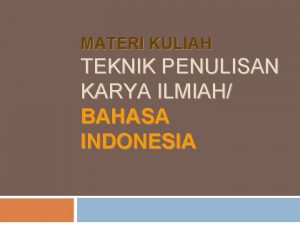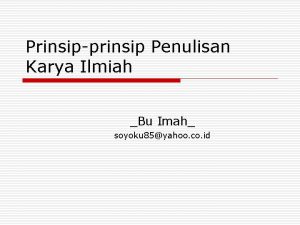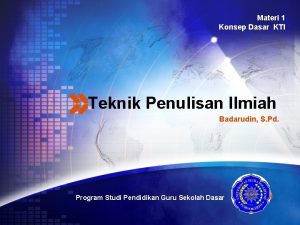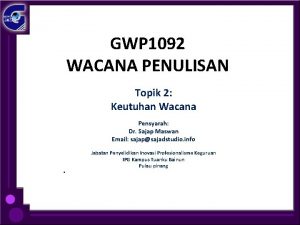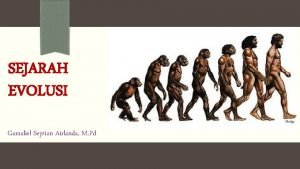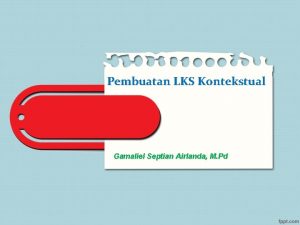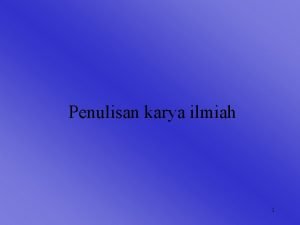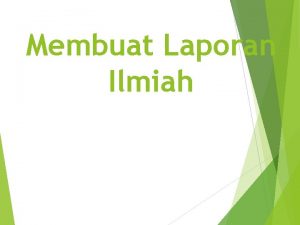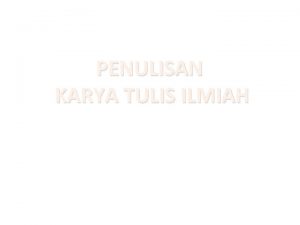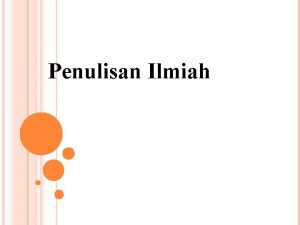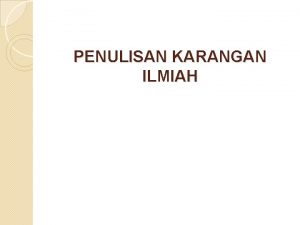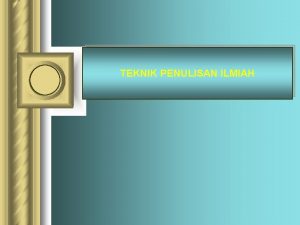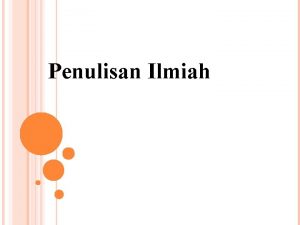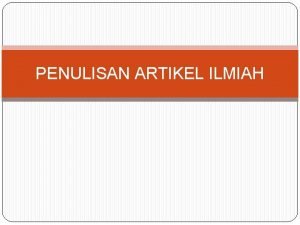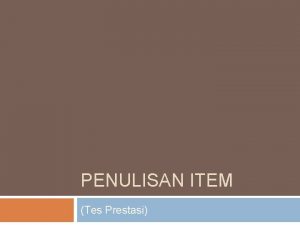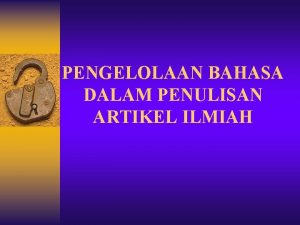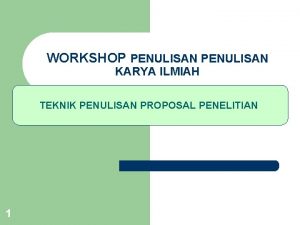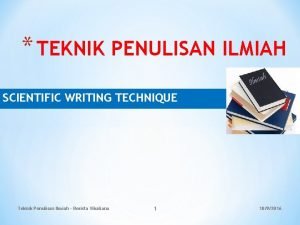PENULISAN ILMIAH Gamaliel Septian Airlanda ALLPPT com Free




















- Slides: 20

PENULISAN ILMIAH Gamaliel Septian Airlanda ALLPPT. com _ Free Power. Point Templates, Diagrams and Charts

Mengapa Menulis Ilmiah ? Hakekat dasar manusia MAHKLUK ILMIAH MASYARAKAT ILMIAH ILMU PENGETAHUAN

Background: Author’s Perspective Motivation to publish: – Dissemination (54% 1 st choice) – Career prospects (20% 1 st choice) – Improved funding (13% 1 st choice) – Ego (9% 1 st choice) – Patent protection (4% 1 st choice) – Other (5% 1 st choice) Bryan Coles (ed. ) The STM Information System in the UK, BL Report 6123, Royal Society, BL, ALPSP, 1993

Kebutuhan Pembaca 1. 2. 3. 4. 5. 6. 7. Menarik Mudah dipahami Kreatif Inovatif Memberi Solusi Valid Bereputasi

Structure of a Paper Scientific writing follows a rigid structure – a format developed over hundreds of years Consequently, a paper can be read at several levels: – Some people just will refer to the title – Others may read only the title and abstract – Others will read the paper for a deeper understanding

Components of a Paper

Authors Listing • ONLY include those who have made an intellectual contribution to the research • OR those who will publicly defend the data and conclusions, and who have approved the final version • Order of the names of the authors can vary from discipline to discipline – In some fields, the corresponding author’s name appears first

Title • Describes the paper’s content clearly and precisely including keywords • Is the advertisement for the article • Do not use abbreviations and jargon • Search engines/indexing databases depend on the accuracy of the title - since they use the keywords to identify relevant articles

Abstract • Briefly summarize (often 150 words) - the problem, the method, the results, and the conclusions so that – The reader can decide whether or not to read the whole article • Together, the title and the abstract should stand on their own • Many authors write the abstract last so that it accurately reflects the content of the paper See: The Structured Abstract: An Essential Tool for Research http: //research. mlanet. org/structured_abstract. html

Introduction • Clearly state the: – Problem being investigated – Background that explains the problem – Reasons for conducting the research • Summarize relevant research to provide context • State how your work differs from published work • Identify the questions you are answering • Explain what other findings, if any, you are challenging or extending • Briefly describe the experiment, hypothesis(es), research question(s); general experimental design or method

Methods • Provide the reader enough details so they can understand replicate your research • Explain how you studied the problem, identify the procedures you followed, and order these chronologically where possible • Explain new methodology in detail; otherwise name the method and cite the previously published work • Include the frequency of observations, what types of data were recorded, etc. • Be precise in describing measurements and include errors of measurement or research design limits

Results • Objectively present your findings, and explain what was found • Show that your new results are contributing to the body of scientific knowledge • Follow a logical sequence based on the tables and figures presenting the findings to answer the question or hypothesis • Figures should have a brief description (a legend), providing the reader sufficient information to know how the data were produced

Discussion/Conclusion • Describe what your results mean in context of what was already known about the subject • Indicate how the results relate to expectations and to the literature previously cited • Explain how the research has moved the body of scientific knowledge forward • Do not extend your conclusions beyond what is directly supported by your results - avoid undue speculation • Outline the next steps for further study

References • Whenever you draw upon previously published work, you must acknowledge the source • Any information not from your experiment and not ‘common knowledge’ should be recognized by a citation • How references are presented varies considerably - refer to notes for authors for the specific journal • Avoid references that are difficult to find • Avoid listing related references that were not important to the study

Harvard Reference Style Uses the author's name and date of publication in the body of the text, and the bibliography is given alphabetically by author – Adams, A. B. (1983 a) Article title: subtitle. Journal Title 46 (Suppl. 2), 617 -619 – Adams, A. B. (1983 b) Book Title. Publisher, New York. – Bennett, W. P. , Hoskins, M. A. , Brady, F. P. et al. (1993) Article title. Journal Title 334 , 31 -35.

Vancouver Reference Style Uses a number series to indicate references; bibliographies list these in numerical order as they appear in the text 1. Adams, A. B. (1983) Article title: subtitle. Journal Title 46 (Suppl. 2), 617 -619. 2. Lessells, D. E. (1989) Chapter title. In: Arnold, J. R. & Davies, G. H. B. (eds. ) Book Title , 3 rd edn. Blackwell Scientific Publications, Oxford, pp. 32 -68. 3. Bennett, W. P. , Hoskins, M. A. , Brady, F. P. et al. (1993) Article title. Journal Title 334 , 31 -35.

Kutipan 1. Bertujuan untuk meyakinkan bahwa gagasan/ide tulisan pernah diteliti atau dibahas oleh peneliti lain. 2. Teori atau gagasan yang diungkapkan dapat dipertanggungjawabkan didukung oleh beberapa orang peneliti. 3. Meyakinkan pembaca bahwa ide/gagasan penulis sungguh dapat diteliti dan diuji kebenarannya. 4. Menunjukkan bahwa memang telah terjadi permasalahan yang hampir sama dengan ide/gagasan penulis 5. Etika pengutipan harus dilakukan. 6. Kutipan bukan merupakan sarana untuk melakukan copy paste

Jurnal Definisi Harafiah 1. Majalah ilmiah yang terkait dengan suatu subjek terspesialisasi 2. Surat kabar harian atau mingguan 3. Laporan tentang kegiatan Kategori Jurnal a. Jurnal Nasional b. Jurnal Nasional Terakreditasi c. Jurnal Internasional d. Jurnal Internasional terindeks • Jurnal Predator

Kriteria Tulisan Ilmiah (Jurnal) 1. 2. 3. 4. 5. 6. 7. 8. 9. Terbaru Tidak Plagiarisme termasuk self plagiarsm Memiliki Produk / Gagasan Baru / Solusi / Teori / Hasil Inovatif, kreatif Gaya bahasa penulisan ilmiah yang baku Valid Sesuai dengan TOR (Term of Reference) dari author jurnal Telah di review dan atau di revisi Singkat, padat, jelas

END
 Contoh karangan ilmiah semi ilmiah dan non ilmiah
Contoh karangan ilmiah semi ilmiah dan non ilmiah Novel laras asa
Novel laras asa Cơm
Cơm Bài thơ mẹ đi làm từ sáng sớm
Bài thơ mẹ đi làm từ sáng sớm Metode ilmiah
Metode ilmiah Kerja ilmiah yang dilandasi sikap ilmiah akan menghasilkan
Kerja ilmiah yang dilandasi sikap ilmiah akan menghasilkan Perbedaan pendekatan ilmiah dan pendekatan non ilmiah
Perbedaan pendekatan ilmiah dan pendekatan non ilmiah Penelitian ilmiah dan non ilmiah
Penelitian ilmiah dan non ilmiah Contoh karangan non ilmiah
Contoh karangan non ilmiah Ayat penanda wacana
Ayat penanda wacana Isi abstrak
Isi abstrak Struktur penelitian dan penulisan ilmiah
Struktur penelitian dan penulisan ilmiah Pengembangan outline
Pengembangan outline Etika penulisan karya ilmiah
Etika penulisan karya ilmiah Materi kuliah teknik penulisan karya ilmiah
Materi kuliah teknik penulisan karya ilmiah Prinsip prinsip penulisan karya ilmiah
Prinsip prinsip penulisan karya ilmiah Konsep dasar penulisan karya ilmiah
Konsep dasar penulisan karya ilmiah Tahap-tahap penulisan karya ilmiah
Tahap-tahap penulisan karya ilmiah Hakikat karya ilmiah dalam mengemukakan
Hakikat karya ilmiah dalam mengemukakan Definisi penulisan ilmiah
Definisi penulisan ilmiah Keutuhan wacana fonologi
Keutuhan wacana fonologi




